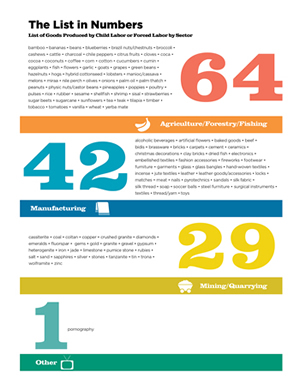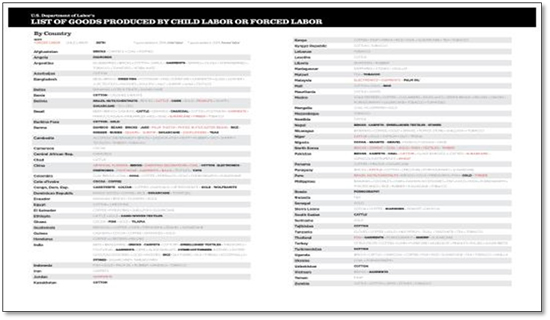Please note: As of January 20, 2021, information in some news releases may be out of date or not reflect current policies.
News Release
US Labor Department announces updated lists of goods produced by child labor, forced labor
WASHINGTON — The sixth edition of the "List of Goods Produced by Child Labor or Forced Labor," mandated by the Trafficking Victims Protection Reauthorization Act of 2005, was released today by the U.S. Department of Labor's Bureau of International Labor Affairs. In accordance with Executive Order 13126, ILAB also published an initial determination to add carpets from India to its "List of Products Produced by Forced or Indentured Child Labor." In addition to publishing this initial determination regarding Indian carpets, ILAB re-released its EO 13126 List from 2013 with additional specific information about the listed products.
"There's a story behind each item on these lists — a child facing back-breaking labor without education or other opportunities for a better life or an adult trapped in a dismal job through deceit or threats," said U.S. Secretary of Labor Thomas E. Perez. "These lists raise awareness about child and forced labor. Through collective efforts we can, and must, work together to end these cycles of exploitation."
New items can be added to the TVPRA List if they are made with child labor, forced labor or both. The 11 goods made with child labor that have been added to the sixth edition of this list are: garments from Bangladesh; cotton and sugarcane from India; vanilla from Madagascar; fish from Kenya; fish from Yemen; alcoholic beverages, meat, textiles, and timber from Cambodia; and palm oil from Malaysia. One good, electronics from Malaysia, has been added to the TVPRA List for being produced with forced labor.
Per the regulations implementing EO 13126, all updates to this list are first published as initial determinations in the Federal Register for public comment. ILAB welcomes public comments on the proposed addition of Indian carpets to the EO List. Comments can be made at http://www.regulations.gov, docket DOL-2014-0004, through Jan. 30, 2015.
The department also re-released its full EO 13126 List from 2013 featuring a new format, with short paragraphs elaborating on each item on this list. "We hope that these additional details provide a more complete picture of the forced child labor behind the listed products, enabling governments, nongovernmental organizations, businesses and consumers to better target their efforts to end these deplorable practices," Secretary Perez added.
"By publishing these lists, our goal is to shed light on the plight of the estimated 168 million child laborers and 21 million forced laborers around the world, especially as they relate specifically to goods we use every day," said Deputy Undersecretary of Labor for International Affairs Carol Pier. "Child labor and forced labor are fundamental human rights violations, and they are also bad business practices that stifle economic development. We look forward to continuing our engagement with these countries, and with stakeholders in the highlighted sectors, to help end this labor exploitation and promote inclusive economic growth."
The TVPRA List was first published on Sept. 10, 2009. The TVPRA of 2013 requires submission of this list to Congress not later than Dec. 1, 2014, and every two years thereafter. Executive Order 13126 was signed by President Bill Clinton in 1999, and ILAB updates this list periodically. Each list has its own mandates and requirements. The TVPRA List has broader coverage, including goods made by any form of exploitative child as well as forced labor of anyone — adults or children. The EO 13126 List covers the smaller sub-set of children working in forced labor conditions. The EO 13126 List is intended to ensure that U.S. federal agencies do not procure goods made by forced or indentured child labor. Under procurement regulations, federal contractors who supply products on the EO 13126 List must certify that they have made a good faith effort to determine whether forced or indentured child labor was used to produce the items supplied.
As part of its ongoing efforts to encourage businesses and industry groups around the world to address child labor and forced labor in their supply chains, in 2012 ILAB published an extensive online resource, Reducing Child Labor and Forced Labor: A Toolkit for Responsible Businesses.Today, ILAB is announcing the release of French and Spanish language versions of this Toolkit. These new translated versions will enable businesses and other interested parties in French- and Spanish-speaking countries to better understand how to identify and address child labor, forced labor and related practices wherever they occur.
ILAB's global mission is to improve working conditions, raise living standards, protect workers' ability to exercise their rights and address the workplace exploitation of children and other vulnerable populations so that workers around the world are treated fairly and able to share in the benefits of the global economy. ILAB has been producing reports to raise awareness globally about child labor and forced labor since 1993. Since 1995, ILAB has also funded projects that provide assistance to vulnerable children and their families. ILAB has funded 280 projects in more than 90 countries to combat the worst forms of child labor.
More information about these lists is available at http://www.dol.gov/ilab/. Printed versions are available from the Office of Child Labor, Forced Labor and Human Trafficking, Bureau of International Labor Affairs, U.S. Department of Labor, 200 Constitution Ave. NW, Room S-5317, Washington, DC 20210. Inquiries can also be made via telephone at 202-693-4843, fax at 202-693-4830 or email at ocft@dol.gov.
Join the conversation on Twitter by using #ChildLabor and tagging @USDOL.


